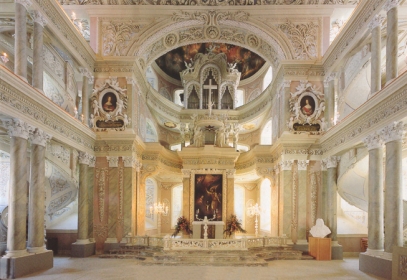

Eisenberg (Thüringen), court chapel
Christoph Donat (1688), remodeled by Tobias Heinrich Gottfried Trost (1731-1733)
State of preservation: Case and a major number of stops by Donat, the renewed technical setup and added stops by Trost. After repairs and the 1917 requisition of front pipes the organ was restored in 1963 and 1986ff.
The organ by Donat (and Trost) in Eisenberg is to be understood as an indispensable part of a baroque room conception. Due to its function as a court chapel the eastern wall with altar, pulpit and organ is is centered towards the ducal lodge. The unusally rich stucco decoration corresponds with the delicately carved organ case in alabaster white.
The Donat organ was designed as a smaller two manuals organ rather typical for protestant central Germany. However, since Duke Christian of Saxe-Eisenberg already needed cutting his lavish expenses, it soon showed first damages. Trost's repair in fact resembled a completely new organ using what was still of use. His changes reveal the changes of musical tastes before and around 1700.
Musikbeispiel:
J.S. Bach : Christ lag in Todesbanden ( Orgelbüchlein), BWV 615
played by Hartmut Haupt
Specification
Disposition (after Trost):
II+P
HW:
Quintadena 16’ (Donat/Trost)
Prinzipal 8’ (1986ff.)
Grobgedackt 8’ (Donat)
Offen Flöte 8’ (Donat)
Floete Travers 8’ (1986ff.; Trost, replacing Donat's Trompeta 8’)
Octava 4’ (Donat)
Rohrflöte 4’ (Donat)
Quinta 3’ (Donat)
Hohlflöte 2’ (Donat)
Mixtur 2’ 5f. (Donat/Trost)
BW:
Gedackt 8’ (Donat)
Principal 4’ (1963)
Nachthorn 4’ (1963)
Spitzflöte 2’ (1963)
Quintflöte 1½’ (1963)
Sifflöte 1’ (1963)
Singend Regal 8’ (1963)
P:
Subbaß 16’ (Trost)
Octavbaß 8’ (Trost, replacing Schalmeyenbaß 4’)
Posaunenbaß 16’ (Donat)
Trompetenbaß 8’ (Donat)
Coupler manuals (Trost), coupler BW/P (1986ff.), Tremulant (1986ff.)
© Greifenberger Institut für Musikinstrumentenkunde | info@greifenberger-institut.de





